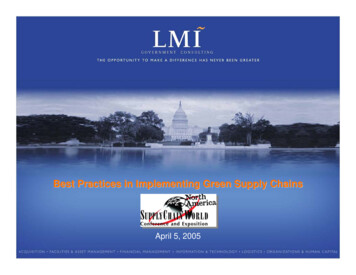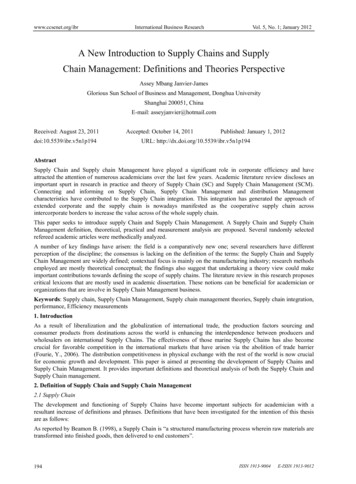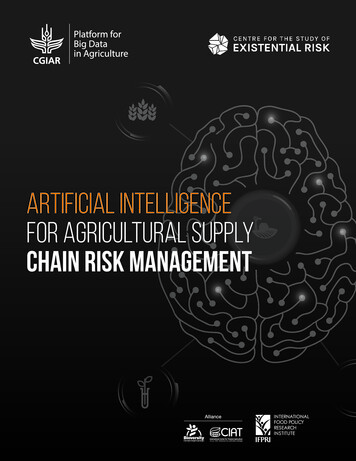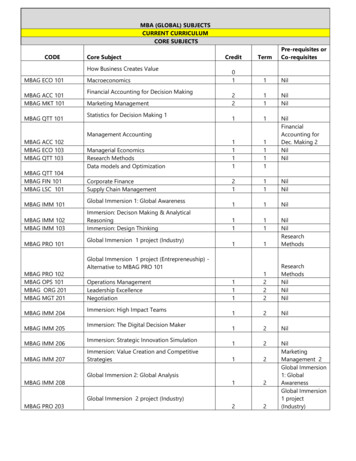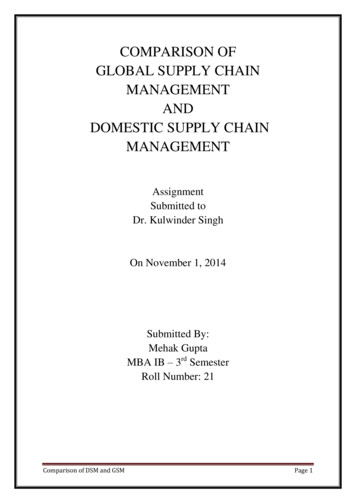
Transcription
GREEN SUPPLY CHAIN MANAGEMENTENABLERS AND BARRIERS INTEXTILE SUPPLY CHAINSWHAT FACTORS ENABLE OR AGGRAVATE THE IMPLEMENTATION OF AGSCM STRATEGY FOR TEXTILE AND FASHION COMPANIES?Thesis for Master, 30 ECTSTextile ManagementKerstin StremlauJoanne TaoYear: 2016Thesis id number: 2016.15.06
Title: Green Supply Chain Management Enablers and Barriers in Textile Supply ChainsPublication year: 2016Author: Stremlau, Kerstin and Tao, JoanneSupervisor: Mattila, HeikkiAbstractPurpose of this paper: The purpose of this paper is to provide an overview of the factors thatenable or aggravate the implementation of a GSCM strategy for textile and fashioncompanies. Moreover, it shall be investigated how textile and fashion companies perceivetheir incentives of implementing GSCM and what their organizational responses regarding theperceived barriers and enablers look like.Design/methodology/approach: The report combines a literature study on previous researchin the field of supply chain management, Green Supply Chain Management and the driversand barriers of implementing a GSCM strategy, with an empirical study consisting of anonline survey, a semi-structured interview and two case studies that are based on literaturereview. In order to analyze the survey results, a method to calculate a company’s GSCMincentive score has been developed.Findings: The factors that have been identified as the strongest or most important ones bymany companies of the survey, as well as the interviewee and the case studies are suppliercollaboration, the lack of supplier commitment, customer demand for more sustainability,customer desire for lower prices and top management commitment. Some companies alsoperceived the alignment of their company’s strategy as strong GSCM enabler. However, thecalculation shows that the overall incentive score of most participants is in the neutral level;meaning that they in total perceive neither significant incentives nor barriers to implementGSCM. With mostly internal enablers and external barriers, more than half of the surveyparticipants can be categorized as Agenda Setters.Research limitations: Due to the low response rate, the sample size of this study is verysmall. Moreover, the results strongly depend on the personal opinion and experiences of theinterviewee and the individual situations of the companies. This means that the results of thisstudy give an indication, but are not generalizable. Therefore, another study with a differentsampling method and a larger sample size is needed.Practical implications: The outcomes of this study show that GSCM concerns every aspectof a supply chain. A company that wants to engage in GSCM needs to have goodrelationships with and control over its suppliers in order to ensure that they fulfill thesustainability requirements, and deal with pressure from NGOs. Additionally, the companyneeds to balance customer demands for low prices and sustainability, expect some (one-time)investments and sacrifice short-term profit in order to ensure sustainable production.Originality/value: This report identifies the most important GSCM barriers and enablers fortextile companies. By evaluating how companies within the textile and fashion sector perceivetheir incentives of implementing GSCM and investigating their organizational behaviortowards barriers and enablers of GSCM, this study indicates what the current situation in thetextile industry looks like; shows where improvements are necessary and gives insight fori
companies that aim to engage in green practices. The development of the so called GSCMincentive score; a method to calculate a company’s perceived incentives to implement aGSCM strategy, can be useful for future studies within this field.AcknowledgmentsThe authors would also like to thank Heikki Mattila for supervision and guidance, JonasLarsson for his support, and the opponent Giuliana Heger for her helpful feedback.KeywordsSustainability, Supply Chain Management, Green Supply Chain Management (GSCM),textile industry, GSCM enabler, GSCM barrierii
List of orporate ResponsibilityCorporate Social ResponsibilityExternal barriersExternal enablersGreen supply chainGreen Supply Chain ManagementInternal barriersInternal enablersLiterature reviewNongovernmental organizationResearch questionSupply chainSupply chain managementSustainable Supply Chain Managementiii
List of figuresFigure 1 Trend of earth overshoot day . - 1 Figure 2 A tier-structured supply chain. - 5 Figure 3 Influencing factors on GSCM practices . - 8 Figure 4 Barriers and enablers of implementing GSCM . - 10 Figure 5 Data collection process . - 17 Figure 6 GSCM incentive score (level of perceived incentives of applying GSCM) . - 21 Figure 7 Typology of organizational responses to SSCM . - 22 Figure 8 GSCM incentive score . - 25 Figure 9 Adoption of green practices . - 26 Figure 10 Country of headquarter . - 27 Figure 11 Organization type . - 27 Figure 12 Organizational response . - 28 Figure 13 Adoption of GSCM . - 29 Figure 14 Country of headquarter . - 29 Figure 15 Organization type . - 30 Figure 16 Number of stores and suppliers of H&M . - 34 Figure 17 Development of programs . - 35 Figure 18 Nike’s system-change initiatives (Nike, Inc. 2013) . - 38 Figure 19 Nike’s performance score in a Chinese factory . - 40 -List of tablesTable 1 Internal enablers and barriers . - 13 Table 2 External enablers and barriers . - 15 Table 3 Trade Fairs . - 18 Table 4 Classification in ITMA, 2015 (ITMA, 2015) . - 19 Table 5 Survey answers and values for calculation . - 20 Table 6 Pairs of similar factors . - 23 Table 7 Developed and developing countries . - 26 Table 8 Breakdown of samples . - 28 Table 9 Identified strong factors . - 31 Table 10 Number of collected contradicting samples . - 31 Table 11 Overview of H&M’s sustainability efforts . - 37 Table 12 Comparison of internal enablers in LR and online survey . - 44 Table 13 Comparison of internal barriers in LR and online survey . - 45 Table 14 Comparison of external enablers in LR and online survey . - 46 Table 15 Comparison of external barriers in LR and online survey . - 46 Table 16 Answering of RQs . - 48 -iv
Table of contents1234567Introduction . - 1 1.1Background . - 1 1.2Problem background . - 2 1.3Research gap . - 2 1.4Purpose and research questions . - 3 1.5Delimitations . - 3 Literature Review . - 4 2.1Supply Chain Management . - 4 2.2Supply Chain Management in textile and fashion industry . - 5 2.3Green Supply Chain Management . - 6 2.4Green Supply Chain Management in textile and fashion industry. - 8 2.5Enablers and Barriers of adopting GSCM. - 9 2.5.1 Internal enablers . - 11 2.5.2 Internal barriers . - 12 2.5.3 External enablers . - 13 2.5.4 External barriers . - 14 Methodology . - 16 3.1Research strategy and design . - 16 3.1.1 Design of survey questionnaire . - 16 3.2Data collection. - 17 3.2.1 Online survey . - 17 3.2.2 Interview. - 19 3.2.3 Case study . - 19 3.3Data analysis . - 19 3.3.1 Online survey . - 19 3.3.2 Interview. - 23 3.3.3 Case study . - 24 3.4Quality criteria and assessment of research . - 24 Results . - 25 4.1Online survey . - 25 4.1.1 Evaluation of GSCM incentives . - 25 4.1.2 Typology of companies . - 27 4.1.3 Identification of Strong Factors . - 30 4.1.4 Identification of Contradicting Factors . - 31 4.2Interview. - 31 4.3Case studies . - 33 4.3.1 H&M . - 33 4.3.2 Nike . - 37 Analysis . - 44 5.1Internal enablers . - 44 5.2Internal barriers . - 45 5.3External enablers . - 45 5.4External barriers . - 46 Discussion . - 47 Conclusion . - 48 v
7.1Contribution . - 49 7.2Future research suggestions . - 49 References . - 51 Appendix I - Interview questions . IAppendix II - Overview of survey answers . IIvi
1 IntroductionThis study identifies enablers and barriers of Green Supply Chain Management (GSCM) andinvestigates how textile and fashion companies perceive their incentives of engaging inGSCM and can be of interest for other researchers investigating the implementation of GSCMin the textile (related) industry, as well as for (textile) companies that consider developing agreen supply chain.1.1 BackgroundGlobal Footprint Network created an index called “Earth Overshoot Day” to measureenvironmental sustainability of humanity. On their website, they explain: “Earth OvershootDay marks the date when humanity’s demand for ecological resources and services in a givenyear exceeds what Earth can regenerate in that year.” Figure 1 below shows a clear trend thatfrom 1970 to 2015 resources demanded by humanity is increasing, whereas Earth OvershootDay fell on December 23 in 1970, November 03 in 1980, October 13 in 1990, October 04 in2000 and August 28 in 2010 calculated with the National Footprint Accounts 2015 Edition(Global Footprint Network, 2015). This trend sends out a strong warning signal that allindustries and all companies within need to work toward a more environmentally sustainablemethod of doing business in order to reverse the current trend.Figure 1 Trend of earth overshoot dayThe fashion industry accounts for 9.3% of world’s employees and 4% of worldwide exportsand has a very strong environmental impact (World Trade Organization, 2008). Most textileand fashion companies nowadays depend on external partners from all over the world toproduce their goods; subcontracting the different production activities from weaving orknitting to sewing and finishing and use raw materials from offshore locations. However thebrand-owning companies are usually the ones held responsible for environmental and socialproblems caused not only by themselves directly, but also by their suppliers. In this context,supply chain management (SCM) has two main purposes; improving the competitiveness ofthe company and allowing it to pursue environmental responsibility (Caniato et al. 2011).1
“Environmental sustainability in fashion concerns not only materials and processes, but alsoimpacts supply chain configuration and management, both up- and down-stream, and cangenerate new business opportunities” (Caniato et al. 2011).Sustainable Supply Chain Management (SSCM) integrates sustainability aspects (social,economic and environmental) into every part of the supply chain, whereas Green SupplyChain Management (GSCM) focuses on the environmental part of sustainability. Certainfactors, such as management commitment and customer demand, can either work as enablersor barriers for textile and fashion companies when developing a GSCM strategy (Ahi andSearcy, 2013; Kant, 2015).1.2 Problem backgroundSupply chain networks have become increasingly integrated and global over the past fewdecades. Especially textile and fashion supply chains mostly include many actors overdifferent continents (Pui-Yan Ho and Choi, 2012). Having an environmentally friendly(green) supply chain means that every actor of the supply network needs to fulfill strictsustainability requirements (Caniato, 2012; Chen et al. 2012). That can be challenging for acompany and requires good control and strong commitment. However, not only thedevelopment of a green supply chain is challenging, but also to keep it sustainable. There areseveral factors inside and outside a company or a supply chain that influence theimplementation and maintenance of a green supply chain. These internal and external factorscan encourage or discourage Green Supply Chain Management (GSCM) and affect differentcompanies to different degrees, depending on the company’s nature and situation.Accordingly, the reaction towards these factors can vary strongly from company to company.Moreover, the factors enabling and aggravating Green Supply Chain Management are alsodifferent from industry to industry and the topic of sustainability only gained largesignificance during the past few decades. This means that this topic is highly complex andfairly new; there is no extensive literature available, not every factor influencing GSCM in thetextile industry might have been identified yet, and there is no clear distinction between whatorganizational response is right or wrong (Caniato, 2012; Chen et al. 2012; Choi and Cheng,2015; Diabat and Govindan, 2011).1.3 Research gapBesides the major research gap of studies about GSCM enablers and barriers that focus on thetextile industry, two other research gaps have been identified: Studies within this field thattake different organization types and regions into consideration and studies that use mixedmethod approaches.Some authors claim that even though there is extensive literature about sustainability and(green) supply chain management, there are only a few studies about GSCM enablers andbarriers with focus on the textile industry, and those that exist mostly study a certainorganization type or region (Caniato, 2012; Diabat et al. 2014; Kant, 2015). “There is nostudy focused to understand the similarities and dissimilarities of GSCM practices across thedifferent types of organizations” (Kant, 2015). Min and Kim, 2012 see a need for studies withhybrid methodologies in this field (Min and Kim, 2012). In regard to the global and farreaching nature of most textile supply chains and the need for more extensive and less narrowstudies, a horizontal research approach that takes the global textile industry into account has2
been chosen for this study. In order to fill the research gap of a study about GSCM enablersand barriers with a mixed-method or hybrid methodology, and giving the research more focus,while keeping the broad approach, this study shall combine different empirical studies.1.4 Purpose and research questionsThe main goal of this report is to find out what factors enable or aggravate the implementationof GSCM for textile and fashion companies. This shall provide an overall picture regardingincentives of adopting GSCM. The second goal is to evaluate how companies within thetextile and fashion value chain perceive their incentives of implementing GSCM andinvestigate their organizational behavior towards barriers and enablers of GSCM. This shallgive an indication what the current situation of the textile and fashion industry looks like,show where improvements should start from and provide insight for companies that aim to goon the same path.This leads to the following research questions:Main research question (RQ):RQ1: What are the factors that enable or aggravate the implementation of a GSCM strategyfor textile and fashion companies?Sub RQs:RQ2: How do textile and fashion companies perceive their incentives of implementing aGSCM strategy?RQ3: What are the organizational responses of textile and fashion companies towardsperceived barriers and enablers?1.5 DelimitationsAlthough literature about GSCM enablers and barriers from other industries has been studied,this report focuses on the textile and fashion industry. Besides, the concept of SustainableSupply Chain Management and social aspects of sustainability (such as labor conditions) havebeen mentioned, but the focus lies on environmental sustainability.The most significant delimitation of this study however is its weak generalizability. Despitethe fact that the perception of how strong certain barriers and enablers affect a company isindividually different and the organizational responses towards it can vary from company tocompany, a significantly larger sample size would allow to generalize the results with morecertainty.3
2 Literature ReviewThe literature review provides the theoretical framework, consisting of two areas of research.In the first section relevant literature on Supply Chain Management (SCM) and Green SupplyChain Management (GSCM) in general and with focus on the textile and fashion industry aresummarized to demonstrate the similarities and differences between SCM and GSCM. Then,the drivers and barriers of transforming SCM to GSCM that have been identified in literatureare presented.A comparative study that analyzed definitions of Green Supply Chain Management (GSCM)and Sustainable Supply Chain Management (SSCM) showed that the two concepts are largelysimilar, with the exception that GSCM focuses on the environmental side of sustainability(Ahi and Searcy, 2013). Since this study also concentrates on environmental aspects, theconcept of GSCM is in the focus. However, literature about both concepts; GSCM andSSCM, as well as other similar programs, has been studied in order to gain a deeperunderstanding of the topic.2.1 Supply Chain ManagementEffective in 2005, the Council of Logistics Management (CLM) changed its name to theCouncil of Supply Chain Management Professionals (CSCMP) (Mhlnews.com, 2004).According to the definitions by CSCMP, supply chain management includes all logisticsmanagement activities. In addition, supply chain management also encompasses coordinationand collaboration with channel partners (CSCMP, 2013). As a matter of fact, the term “supplychain management” has grown popularity over the term “logistics management” since the1980s (Waters, 2011). This trend is in line with the interest of manufacturers and serviceproviders to collaborate with their suppliers integrating the purchasing and supplymanagement functions during the 1990s (Tan, 2001). However, back in 1958, Forrester hadpointed out that integrating activities has been a developing theme of logistics for decades. AsWaters (2011) pointed out, the pursuit of own individual benefits among supply chainpartners is one of the reasons integration of the supply chain is more of an ideal than reality.Tan (2001) holds a similar stand, stating: “Technically, the value chain is too complex toachieve a full integration of all business entities within it in order to reap the benefits offeredby supply chain management.” Some prefer using the term “supply chain network”, whichimplicates a tier-structured supply chain as illustrated in Figure 2. A tier-structured supplychain describes the fact that every focal company faces their own supplier base and customerbase, while each of their supplier and customer face also their own supplier base and customerbase that the focal company does not have direct contact of. The figure shows the complexityand provides an outlook of why full integration (aligning interests of all parties) of supplychain is impossible.4
Figure 2 A tier-structured supply chainAdapted from Jespersen and Skjott-Larsen, 2005Apart from the objective of coordination and collaboration with channel partners of SCM, theother pillar of SCM is within the focal company which is often referred as logisticsmanagement. A survey asking companies to list their top three objectives for logistics foundout that cost reduction, improved customer responsiveness, profitable growth and shortercycle times are the most common answers (Iglesias et al, 2008). By using the Supply ChainOperation Reference (SCOR) model, how companies use logistics management to achievetheir objectives can be better understood. The SCOR model breaks the operations down into 5function processes. These functions are planning, sourcing, manufacturing, distribution andreturn. The planning function refers to the process of developing a plan for the sourcing,manufacturing and distribution function to follow in pursuit of balancing demand and supply.The sourcing function refers to the process of buying goods or services in order to fulfilldemand through supplier management. The manufacturing function refers to the process oftransforming materials sourced into finished products to fulfill demand. The distributionfunction refers to the process of delivering finished products to customers. The return functionrefers to the logistics of the returning of products either for quality reasons, recycling orcustomer support services (Scott, Lundgren and Thompson, 2011).“Initially, SCM focused primarily on material flows. More recent research emphasizesadditional aspects of SCM, such as risk, performance and integration. There is also a growingemphasis on information flows, internal and external networks of relationships andgovernance of supply networks” (Ahi and Searcy, 2013).2.2 Supply Chain Management in textile and fashion industryThe textile and fashion industry can be divided into three segments, using retail price as acriterion, mass market competes in the lowest price range; prêt-à-porter in the highest andbridge in the middle, each segment has different key success factors and strategic variables.Out of the three segments, companies within mass market and bridge gain competitiveadvantages through supply chain management related activities, while companies within prêtà-porter mainly competes with their designer label (De Koster and Delfmann, 2005). Shortproduct life cycles, high impulse purchase, high volatility and low predictability of demand5
are the four characteristics typically found in the fashion industry (Christopher and Peck,1997). Above listed characteristics combine with common strategies taken by fashioncompanies create an environment that is challenging for supply chain management. Apparelmanufacturing, as a labor-intensive process, takes advantage of low labor cost in Far Eastcountries. Despite the cost reduction benefit, off-shore outsourcing leads to significantlylonger lead times. Average time for transforming raw materials into apparel displayed onstore shelves was estimated to be 66 weeks, with only 11 weeks take up with actualproduction (Al‐Zubaidi and Tyler, 2004) another source estimated that lead time is 390 days,with 37 days of actual production (Waters, 2011). Other strategies mentioned by Abernathy,et al (1999) are products proliferation and increasing percentage of fashion garments. Bothstrategies result in increasing number of SKUs, which further raise unpredictability ofdemand. Consequently, along with the factor of longer lead times, carrying cost becamehigher, stock-outs; mark downs were observed more often (Christopher and Peck, 1997).Quick Response (QR) therefore became a widely used concept in clothing industry where theaim is to replace the old practice of pre-ordering before start of season with frequent in-seasonreordering of apparel by retailers (Al‐Zubaidi and Tyler, 2004). However, even with 100%EDI (Electronic Data Interchange) linkage between retailers and suppliers among Fortune 500companies in the textile and clothing industry (Gilbert and Reichert, 1997), researchers haveidentified obstacles putting QR into practices, such as time required to develop deep trustingpartnerships within the value chain, difficulty and cost of assessing performance, cost and riskof implementing QR practices and lack of knowledge to utilize POS data (Al‐Zubaidi andTyler, 2004). Emerging after QR strategy, Fast fashion is another strategy adopted by manyglobal retailers where the aim is “adapting merchandise assortments to current and emergingtrends as quickly and effectively as possible (Sull and Turconi, 2008).” Compared to otherindustries, “Impact of product design complexity on supply chain risk is e
i Title: Green Supply Chain Management Enablers and Barriers in Textile Supply Chains Publication year: 2016 Author: Stremlau, Kerstin and Tao, Joanne Supervisor: Mattila, Heikki Abstract Purpose of this paper: The purpose of this paper is to provide an overview of the factors that enable or aggravate the implementation of a GSCM strategy for textile and fashion


